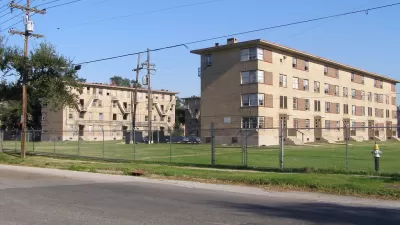The amendment is a thorn in the side of affordable housing advocates, who blame "Faircloth Limits" for inhibiting public housing construction.

As the debate over federal housing policy heats up, Jared Brey provides a concise explanation of the Faircloth Amendment, a 1990s-era rule that has been a recent target of affordable housing advocates. Touted as the "first step to addressing the country’s housing affordability problem" by Ross Barkan in the New York Times, repealing the amendment would "remove a legal obstacle to a series of ambitious housing plans that progressives have rallied behind."
Introduced as part of the 1998 Quality Housing and Work Responsibility Act, the Faircloth Amendment amended the Housing Act of 1937 to maintain public housing units at 1999 levels, effectively preventing housing authorities from ever maintaining more public housing than they did then. The amendment was enacted amid a broader welfare reform movement "grounded in a belief that public assistance programs were detrimental to people’s ability to achieve economic independence." In the 1990s, many lawmakers had a perception of public housing as "crime-infested, unhealthy places that kept people trapped in poverty."
However, "Faircloth Limits" aren't the biggest factor in limiting affordable housing. "Since the 1980s, the restriction of federal funding has had a much bigger impact on public housing than the Faircloth Amendment," and many cities own fewer units than their Faircloth limits allow. A lack of federal funding is the most pressing obstacle facing affordable housing production, but with proposals like the Green New Deal for Public Housing on the table, which calls for $180 billion in spending, significant change in federal housing policy seems more possible.
FULL STORY: What Is the Faircloth Amendment?

Alabama: Trump Terminates Settlements for Black Communities Harmed By Raw Sewage
Trump deemed the landmark civil rights agreement “illegal DEI and environmental justice policy.”

Study: Maui’s Plan to Convert Vacation Rentals to Long-Term Housing Could Cause Nearly $1 Billion Economic Loss
The plan would reduce visitor accommodation by 25% resulting in 1,900 jobs lost.

Planetizen Federal Action Tracker
A weekly monitor of how Trump’s orders and actions are impacting planners and planning in America.

Waymo Gets Permission to Map SF’s Market Street
If allowed to operate on the traffic-restricted street, Waymo’s autonomous taxis would have a leg up over ride-hailing competitors — and counter the city’s efforts to grow bike and pedestrian on the thoroughfare.

Parklet Symposium Highlights the Success of Shared Spaces
Parklets got a boost during the Covid-19 pandemic, when the concept was translated to outdoor dining programs that offered restaurants a lifeline during the shutdown.

Federal Homelessness Agency Places Entire Staff on Leave
The U.S. Interagency Council on Homelessness is the only federal agency dedicated to preventing and ending homelessness.
Urban Design for Planners 1: Software Tools
This six-course series explores essential urban design concepts using open source software and equips planners with the tools they need to participate fully in the urban design process.
Planning for Universal Design
Learn the tools for implementing Universal Design in planning regulations.
Caltrans
Smith Gee Studio
Institute for Housing and Urban Development Studies (IHS)
City of Grandview
Harvard GSD Executive Education
Toledo-Lucas County Plan Commissions
Salt Lake City
NYU Wagner Graduate School of Public Service





























